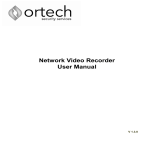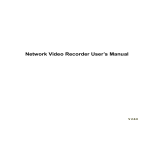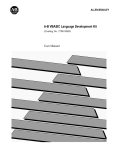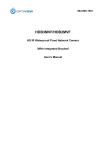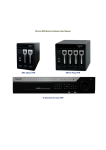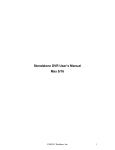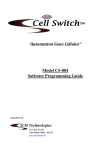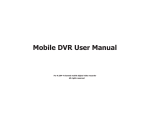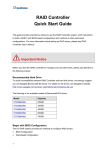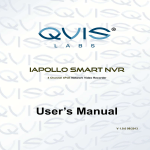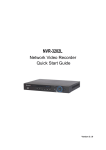Download Network Video Recorder User`s Manual
Transcript
Software Manual Username: admin Password: 1234 Table of Contents 1 GUI Operation.......................................................................................................................................5 1.1 Login...............................................................................................................................................5 1.2 Main Menu.....................................................................................................................................6 1.3 Search & Playback .......................................................................................................................7 1.4 Information ..................................................................................................................................10 1.4.1 1.4.2 1.4.3 1.4.4 1.4.5 1.5 HDD Information ..................................................................................................................10 Bit Rate ................................................................................................................................. 11 Log .........................................................................................................................................12 Version ..................................................................................................................................13 Online Info ............................................................................................................................13 Setting ..........................................................................................................................................14 1.5.1 System ..................................................................................................................................14 1.5.2 Compression ........................................................................................................................16 1.5.3 Schedule ...............................................................................................................................17 1.5.4 RS232 ...................................................................................................................................18 1.5.5 Network .................................................................................................................................19 1.5.5.1 Advanced Setup .........................................................................................................20 1.5.5.2 Authorization ...............................................................................................................20 1.5.5.3 NTP ..............................................................................................................................21 1.5.5.4 Multiple Cast Setup ....................................................................................................22 1.5.5.5 PPPoE..........................................................................................................................23 1.5.5.6 DDNS Setup................................................................................................................23 1.5.5.7 UPNP ...........................................................................................................................24 1.5.5.8 Email ............................................................................................................................25 1.5.5.9 FTP ...............................................................................................................................26 1.5.5.1 Alarm center ................................................................................................................28 1.5.6 Alarm .....................................................................................................................................28 1.5.7 Detect .....................................................................................................................................31 1.5.8 PTZ ........................................................................................................................................35 1.5.9 Display ...................................................................................................................................37 1.5.10 Default....................................................................................................................................38 1.6 Advanced.....................................................................................................................................40 1.6.1 1.6.2 1.6.3 HDD Management...............................................................................................................40 Abnormity..............................................................................................................................43 Alarm Output ........................................................................................................................44 1.6.4 Manual Record.....................................................................................................................45 1.6.4.1 Manual record menu ..................................................................................................45 1.6.5 Account .................................................................................................................................46 1.6.5.1 Modify Password ........................................................................................................47 1.6.5.2 Add/Modify Group ......................................................................................................47 1.6.5.3 Add/Modify User .........................................................................................................48 1.6.6 Auto Maintenance ...............................................................................................................48 1.6.7 Config Backup......................................................................................................................49 2 3 1.7 Remote Device (EN and ENC series only).............................................................................49 1.8 Video Backup ..............................................................................................................................50 1.9 Shutdown.....................................................................................................................................51 Quick Configuration Tool...................................................................................................................53 2.1 Overview ......................................................................................................................................53 2.2 Operation .....................................................................................................................................53 Web ......................................................................................................................................................56 3.1 General Introduction ..................................................................................................................56 3.1.1 3.1.2 3.2 Main Interface .............................................................................................................................58 3.2.1 3.2.2 3.2.3 3.2.4 3.2.5 3.2.6 3.3 Preparation ...........................................................................................................................56 Log in .....................................................................................................................................56 Monitor Channel Menu Tree ..............................................................................................58 System Menu .......................................................................................................................60 Monitor Window Switch ......................................................................................................60 Preview Window Switch .....................................................................................................60 PTZ Control ..........................................................................................................................60 Color and More Setup.........................................................................................................62 Configuration ...............................................................................................................................63 3.3.1 System Information .............................................................................................................63 3.3.1.1 Version Information ....................................................................................................63 3.3.1.2 HDD information .........................................................................................................64 3.3.1.3 Log ................................................................................................................................64 3.3.2 System Configuration .........................................................................................................65 3.3.2.1 General Setup .............................................................................................................65 3.3.2.2 Encode .........................................................................................................................68 3.3.2.3 Schedule ......................................................................................................................69 3.3.2.4 RS232 ..........................................................................................................................70 3.3.2.5 Network ........................................................................................................................71 Advanced setup .................................................................................................................................72 3.3.2.6 Alarm ............................................................................................................................79 3.3.2.1 Detect ...........................................................................................................................81 3.3.2.2 PTZ ...............................................................................................................................83 3.3.2.3 Default & Backup ........................................................................................................83 3.3.3 Advanced ..............................................................................................................................84 3.3.3.1 HDD Management .....................................................................................................84 3.3.3.2 Abnormity.....................................................................................................................86 3.3.3.3 Alarm I/O......................................................................................................................87 3.3.3.4 Record..........................................................................................................................88 3.3.3.5 Account ........................................................................................................................89 3.3.3.6 Auto Maintenance ......................................................................................................90 3.3.3.7 Remote device ................................................................................................................91 3.3.4 Additional Function ..............................................................................................................92 3.3.4.1 Auto register ................................................................................................................92 3.3.4.2 DNS ..............................................................................................................................92 3.4 Search ..........................................................................................................................................93 3.5 Alarm ............................................................................................................................................94 3.6 About ............................................................................................................................................95 3.7 Log out .........................................................................................................................................95 4 FAQ ......................................................................................................................................................97 5 Appendix A HDD Capacity Calculation .........................................................................................102 6 Appendix B Compatible SATA HDD..............................................................................................103 7 Appendix C Compatible USB List ..................................................................................................105 8 Appendix D Compatible Displayer List..........................................................................................107 9 Appendix E No-IP DDNS ................................................................................................................108 Appendix H Toxic or Hazardous Materials or Elements..................................................................... 112 1 GUI Operation Connect the device to the monitor, insert the mouse and connect the power cable. Push the on/off button in the rear panel and then you can see the analog video output. You can use the mouse to implement some simple GUI operation. Please refer to the following chapter for detail information. All the operations listed below are based on our 4-ch series device. 1.1 Login After device booted up, the system is in multiple-channel display mode. See Figure 1-1. You can overlay the corresponding date, time and channel name on each screen. You can refer to the following sheet for channel record or alarm status information. 1 Recording status 3 Live View Zoom 2 Motion detection 4 Camera lock Figure 1-1 Click on Login and See Figure 1-2 The Login window interface. System consists of four accounts: Username: admin Password: 1234 Username: user Password: user Username: guest Passwords: guest Username: default Please select proper username and use the mouse to input the password. Click to switch between small English character or capitalized. Click on the black field to open the virtual keyboard Note: Within the span of 30 minutes, if the wrong password is used to login three times, account locked will initiate. System will beep and account will be disabled for 20mins Figure 1-2 1.2 Main Menu After you logged in, click on the main screen, Main menu is shown as below. See Figure 1-3. There are total seven icons: Search, Information, DVR Setup, Advance Setup, Video Backup, System Shutdown and Remote Device. Remote Device will only show for the EN-series, ENC-series and EH-series DVRs . Move the cursor to highlight the icon, then double click mouse to enter the sub-menu. Figure 1-3 1.3 Search & Playback Click search button in the main menu, search interface is shown as below. See Figure 1-4. Figure 1-4 Please refer to the following sheet for more information. SN 1 2 Name Display window Function Here is to display the searched picture or file. Support 1/4/9/16-window playback.(System channel dependent) Here you can select to search the picture or the recorded file. When there is displayed picture on the left pane, you can set the corresponding setup Search type 3 Calendar The blue highlighted date means there is picture or file. Otherwise, there is no picture or file. In any play mode, click the date you want to see, you can see the corresponding record file trace in the time bar. 4 Playback mode and channel selection pane. Playback mode:1/4/9/16. (It may vary due to different series.) In 1-window playback mode: you can select 1-16 channels. In 4-window playback mode: you can select 4 channels according to your requirement. In 9-window playback mode, you can switch between 1-9 and 10-16 channels. In 16-window playback mode, you can switch between1-16 and 17-32 channels. The time bar will change once you modify the playback mode or the channel option. 5 File list switch button Double click it, you can view the picture/record file list of current day. The file list is to display the first channel of the record file. The system can display max 128 files in one time. Use the / or the mouse to view the file. Select one item, and then double click the mouse or click the ENTER button to playback. You can input the period in the following interface to begin accurate search. File type:R—regular record; A—external alarm record;M—Motion detect record. When system is playing, you can select a zone in the window to begin motion detect. Click the motion detect button to begin play. Current button is null once the motion detect play has begun. The system will take the whole play zone as the motion detect region by default. The motion detect play stopped once you switch the play file. Operations such as set time bar, click the play button, or any file list operation will stop current motion detect play. 6 Play/Pause There are three ways for you to begin playback. The play button Double click the valid period of the time bar. Double click the item in the file list. In slow play mode, click it to switch between play/pause. Stop 7 Playback control pane. Backward play In normal play mode, left click the button, the file begins backward play. Click it again to pause current play. In backward play mode, click ►/ to restore normal play. In playback mode, click it to play the next or the previous section. You can click continuously when you are watching the files from the same channel. In normal play mode, when you pause current play, you can click │ and │ to begin frame by frame playback. In frame by frame playback mode, click ►/ to restore normal playback. Slow play In playback mode, click it to realize various slow play modes such as slow play 1, slow play 2, and etc. Fast forward In playback mode, click to realize various fast play modes such as fast play 1,fast play 2 and etc. Note: The actual play speed has relationship with the software version. The volume of the playback 8 Time bar Click the snapshot button in the full-screen mode, the system can snapshot 1 picture per second. It is to display the record type and its period in current search criteria. In 4-window playback mode, there are corresponding four time bars. In other playback mode, there is only one time bar. Use the mouse to click one point of the color zone in the time bar, system begins playback. The time bar is beginning with 0 o'clock when you are setting the configuration. The time bar zooms in the period of the current playback time when you are playing the file. The green color stands for the regular record file. The red color stands for the external alarm record file. The yellow stands for the motion detect record file. Time bar unit ●The option includes: 24H, 12H, 1H and 30M. The smaller the unit, the larger the zoom rate. You can accurately set the time in the time bar to playback the record. The time bar is beginning with 0 o'clock when you are setting the configuration. The time bar zooms in the period of the current playback time when you are playing the file. Backup Select the file(s) you want to backup from the file list. System max supports files from four channels. Then click the backup button, now you can see the backup menu. Click the start button to begin the backup operation. Check the file again you can cancel current selection. System max supports to display 32 files from one channel. 11 Clip It is to edit the file. ●Please play the file you want to edit and then click this button when you want to edit. You can see the corresponding slide bar in the time bar of the corresponding channel. You can adjust the slide bar or input the accurate time to set the file end time. Click this button again and then save current contents in a new file. . 12 Record type In any play mode, the time bar will change once you modify the search type. 9 10 Other Functions 15 Other channel synchronization switch to play when playback When playing the file, click the number button, system can switch to the same period of the corresponding channel to play. Digital zoom When the system is in full-screen playback mode, left click the mouse in the screen. Drag your mouse in the screen to select a section and then left click mouse to realize digital zoom. You can right click mouse to exit. Note: All the operations here (such as playback speed, channel, time and progress) have relationship with hardware version. Some series NVRs do not support some functions or playback speeds. 1.4 Information Here is for you to view system information. There are total five items: HDD (hard disk information), BPS (data stream statistics), Log and version, and online user. See Figure 1-5. Figure 1-5 1.4.1 HDD Information HDD information shows hard disk type, total space, free space, and status. See Figure 1-6. Please see “Hardware Manual” for exact Sata support. Figure 1-6 Figure 1-7 In Figure 1-6, click “View record time” button, HDD record time information interface is shown as in Figure 1-7. SATA ○ current HDD is normal. SATA - there is no HDD or no HDD present. SATA ? HDD Error needs replacement Parameter Function SATA 1-8 here means the number of HDD. (no of HDD dependent on model) SN No of HDD install on the system (No)* current HDD used. Type The corresponding HDD property. Total space The HDD total capacity. Free space The HDD free capacity. Status HDD can work properly or not. Page up Click it to view previous page. Page down Click it to view the next page. View recording time Click it to view HDD record information (file start time and end time). View HDD type and capability Click it to view HDD property, status and etc, 1.4.2 Bit Rate Here is for you to view current video data stream (KB/s) and occupied hard disk storage (MB/h). See Figure 1-8. Number of Channel is system dependent. Figure 1-8 1.4.3 Log Here is for you to view system log file. System lists the following information. See Figure 1-9. Log types include system operation, configuration operation, data management, alarm event, record operation, log clear and etc. Please select start time and end time, then click search button. You can view the log files. System max displays 100 logs in one page. It can max save 1024 log files. Please page up/down button to view if there are more than ten files. System also supports the backup function; you can click the backup button to save the log files in the USB devices. Figure 1-9 Click the Details button or double click the log item, you can view the detailed information. See Figure 1-10. Figure 1-10 1.4.4 Version View some version information. See Figure 1-11. Channels Number of video input supported Alarm In Number of alarm input supported Alarm Out Number of alarm output supported Version Software version Build Data Software build date Web Version Web software version Software Serial No. Serial no. for software MAC Address Network MAC Start Upgrade thru USB stick Figure 1-11 1.4.5 Online Info Here is for you manage online users connected to the local device. See Figure 1-12. You can disconnect one user or block one user if you have proper system right. Figure 1-12 1.5 Setting System setting interface is shown as below. See Figure 1-13. Figure 1-13 Note: Please note admin user rights is needed to do the following operation. 1.5.1 System General setting includes the following items. See Figure 5-3 . System time: Here is for you to set system time Date format: There are three types: YYYYY-MM-DD: MM-DD-YYYYY or DD-MM-YYYY. Date separator: There are three denotations to separate date: dot, beeline and solidus. DST: Here you can set DST time and date. Please enable DST function and then click set button. You can see an interface is shown as in Figure 1-15. Here you can set start time and end time by setting corresponding week setup. In Figure 1-15, enable date button, you can see an interface is shown as in Figure 1-16. Here you can set start time and end time by setting corresponding date setup. Time format: There are two types: 24-hour mode or 12-hour mode. Language: System supports various languages: Chinese (simplified), Chinese (Traditional), English, Italian, Japanese, French, Spanish (All languages listed here are optional. Slight difference maybe found in various series.) HDD full: Here is for you to select working mode when hard disk is full. There are two options: stop recording or rewrite. If current working HDD is overwritten or the current HDD is full while the next HDD is no empty, then system stops recording, If the current HDD is full and then next HDD is not empty, then system overwrites the previous files. Pack duration: Here is for you to specify record duration. The value ranges from 60 to 120 minutes. Default value is 60 minutes. X357H357H357H X NVR No: When you are using one remote control (not included in the accessory bag) to control several NVRs, you can give a name to each NVR for your management. Video standard: There are two formats: NTSC and PAL. Auto logout: Here is for you to set auto logout interval once login user remains inactive for a specified time. Value ranges from 0 to 60 minutes. Startup wizard: Once you check the box here, system will go to the startup wizard directly when the system restarts the next time. Otherwise, it will go to the login interface. Device ID: Please input a corresponding device name here. Note: Since system time is very important, do not modify time casually unless there is a must! Before your time modification, please stop record operation first! After completing all the setups please click save button, system goes back to the previous menu. Figure 1-14 Figure 1-15 Figure 1-16 1.5.2 Compression Compression setting includes the following items. System Dependent See Figure 1-17. The Following information is system and camera dependent. See System Hardware Manual Channel: Select the channel you want. Type: Please select from the dropdown list. There are three options: regular/motion detect/alarm. You can set the various encode parameters for different record types. Compression: System supports H.264. Resolution: The mainstream resolution type Generally there are CIF/2CIf/D1/720P/1080P. Frame rate: It ranges from 1f/s to 25f/s in PAL mode and 1f/s to 30f/s in NTSC mode. Bit rate type: System supports two types: CBR and VBR. In VBR mode, you can set video quality. Quality: There are six levels ranging from 1 to 6. The sixth level has the highest image quality. Video/audio: You can enable or disable the video/audio. Overlay: Click overlay button, you can see an interface is shown in Figure 1-18. Cover area (Privacy mask): Here is for you to set privacy mask section. You can drag you mouse to set proper section size. In one channel video, system max supports 4 zones in one channel. Preview/monitor: privacy mask has two types. Preview and Monitor. Preview means the privacy mask zone cannot be viewed by user when system is in preview status. Monitor means the privacy mask zone cannot be view by the user when system is in monitor status. Time display: You can select system displays time or not when you playback. Please click set button and then drag the title to the corresponding position in the screen. Channel display: You can select system displays channel number or not when you playback. Please click set button and then drag the title to the corresponding position in the screen. Please highlight icon to select the corresponding function. Snapshot button: Interface is shown in Figure 1-18. Mode – Timing: system will take snapshot every capture frequency set – Trigger: Motion or Alarm input start the snapshot Images size: system resolution Image Quality: 6 highest and 1 is lowest quality Capture Frequency: how many seconds per image Figure 1-17 Figure 1-18 Figure 1-19 1.5.3 Schedule By default the DVR system is on 24-hour motion detection mode. You can set record type and time in schedule interface. See Figure 1-20. Channel: Please select the channel number first. You can select “all” if you want to set for the whole channels. Week day: There are eight options: ranges from Saturday to Sunday and all. Record types: There are four types: regular, motion detection (MD), Alarm, MD & alarm. There are color bars for your reference. Green color stands for regular recording, Blue color stands for motion detection and red color stands for alarm recording. The white means the view only no recording. Figure 1-20 Shortcut settings: Users can copy the settings of channel 1 to channel 2, by choose channel 1 and click the copy button after relevant settings are done, then paste to channel 2, you can find that the configuration of channel 1 is the same as that of channel 2. Users can save the configuration of each channel respectively or save the configuration all at once ultimately. 1.5.4 RS232 RS232 interface is shown as below. There are five items. See Figure 1-21. Function: There are various devices for you to select. Console is for you to use the COM or mini-end software to upgrade or debug the program. The control keyboard is for you to control the device via the special keyboard. Transparent COM (adapter) is to connect to the PC to transfer data directly. Protocol COM is for card overlay function. Network keyboard is for you to use the special keyboard to control the device. PTZ matrix is to connect to the peripheral matrix control. Baud rate: You can select proper baud rate. Data bit: You can select proper data bit. The value ranges from 5 to 8. Stop bit: There are three values: 1/1.5/2. Parity: there are five choices: none/odd/even/space mark. System default setup is: Function: Console Baud rate:115200 Data bit:8 Stop bit:1 Parity: None After completing all the setups please click save button, system goes back to the previous menu. Figure 1-21 1.5.5 Network Here is for you to input network information. See Figure 1-22. IP address: Here you can input IP address. DHCP: It is to auto search IP. When enable DHCP function, you cannot modify IP/Subnet mask /Gateway. These values are from DHCP function. If you have not enabled DHCP function, IP/Subnet mask/Gateway display as zero. You need to disable DHCP function to view current IP information. Besides, when PPPoE is operating, you cannot modify IP/Subnet mask /Gateway. TCP port: Default value is 4000. UDP port: Default value is 4001. HTTP port: Default value is 80. RTSP port: Default value is 554. Max connection: system support maximal 20 users. 0 means there is no connection limit. Preferred DNS server: DNS server IP address. Alternate DNS server: DNS server alternate address. Transfer mode: Here you can select the priority between fluency/video qualities. LAN download: System can process the downloaded data first if you enable this function. The download speed is 1.5X or 2.0X of the normal speed. After completing all the setups please click save button, system goes back to the previous menu. Figure 1-22 1.5.5.1 Advanced Setup Advanced setup interface is shown as in Figure 1-23. Please draw a circle to enable corresponding function and then double click current item to go to setup interface. Figure 1-23 1.5.5.2 Authorization IP filter interface is shown as in Figure 1-24. You can add IP in the following list. The list supports max 64 IP addresses. Please note after you enabled this function, only the IP listed below can access current NVR. If you disable this function, all IP addresses can access current NVR. Figure 1-24 1.5.5.3 NTP NTP setup interface is shown as in Figure 1-25. Host IP: Input your PC address. Port: This series NVR supports TCP transmission only. Port default value is 123. Update interval: minimum value is 1. Max value is 65535. (Unit: minute) Time zone: select your corresponding time zone here. Here is a sheet for your time zone setup. City /Region Name Time Zone London GMT+0 Berlin GMT+1 Cairo GMT+2 Moscow GMT+3 New Deli GMT+5 Bangkok GMT+7 Beijing (Hong Kong) GMT+8 Tokyo GMT+9 Sydney GMT+10 Hawaii GMT-10 Alaska GMT-9 Pacific Time(P.T) GMT-8 American Mountain Time(M.T) GMT-7 American Central Time(C.T) GMT-6 American Eastern Time(E.T) GMT-5 Atlantic Time GMT-4 Brazil GMT-3 Middle Atlantic Time GMT-2 Figure 1-25 1.5.5.4 Multiple Cast Setup Multiple-cast setup interface is shown as in Figure 1-26. Figure 1-26 Here you can set a multiple cast group. Please refer to the following sheet for detailed information. IP multiple cast group address -224.0.0.0-239.255.255.255 -“D” address space The higher four-bit of the first byte=”1110” Reserved local multiple cast group address -224.0.0.0-224.0.0.255 -TTL=1 When sending out telegraph -For example 224.0.0.1 All systems in the sub-net 224.0.0.2 All routers in the sub-net 224.0.0.4 DVMRP router 224.0.0.5 OSPF router 224.0.0.13 PIMv2 router Administrative scoped addressees -239.0.0.0-239.255.255.255 -Private address space Like the single broadcast address of RFC1918 Can not be used in Internet transmission Used for multiple cast broadcast in limited space. Except the above mentioned addresses of special meaning, you can use other addresses. For example: Multiple cast IP: 235.8.8.36 Multiple cast PORT: 3666. After you logged in the Web, the Web can automatically get multiple cast address and add it to the multiple cast groups. You can enable real-time monitor function to view the view. Please note multiple cast function applies to special series only. 1.5.5.5 PPPoE PPPoE interface is shown as in Figure 1-27. Input “PPPoE name” and “PPPoE password” you get from your ISP (Internet service provider). Click save button, you need to restart to activate your configuration. After rebooting, NVR will connect to internet automatically. The IP in the PPPoE is the NVR dynamic value. You can access this IP to visit the unit. Figure 1-27 1.5.5.6 DDNS Setup DDNS setup interface is shown as in Figure 1-28. DDNS is use when the IP address provided the internet service provider is dynamic. Figure 1-28 Please note DDNS type includes: DVRID.com, NO-IP DDNS and Dyndns DDNS. All the DDNS can be valid at the same time, you can select as you requirement. DVRID.com: Free DDNS service provided with every Watchnet system. DDNS Type: DVRID.com Server IP: dvrid.com Port: 80 Site Name: manuel.dvrid.com (site name is created with the dvrid.com website) Username: [email protected] (username with dvrid.com website) Password: Password created with dvrid.com Update Period: 300 leave defualt See appendix 9 for full DDNS settings 1.5.5.7 UPNP The UPNP protocol is to establish a mapping relationship between the LAN and the WAN. Please input the router IP address in the LAN in Figure 1-22. Double click the UPNP item in Figure 1-22, you can see the following interface. See Figure 1-29. UPNP on/off :Turn on or off the UPNP function of the device. Status: When the UPNP is offline, it shows as “Unknown”. When the UPNP works it shows “Success” Router LAN IP: It is the router IP in the LAN. WAN IP: It is the router IP in the WAN. Port Mapping list: The port mapping list here is the one to one relationship with the router’s port mapping setting. Enable Switch List: : :It shows that the function of port mapping is enabled in this port. Service name:Defined by user. Protocol: Protocol type Internal port:Port that has been mapped in the router. External port:Port that has been mapped locally. Default: UPNP default port setting is the HTTP, TCP and UDP of the NVR. Add to the list: Click it to add the mapping relationship. Delete: Click it to remove one mapping item. Double click one item; you can change the corresponding mapping information. See Figure 1-30. Important: When you are setting the router external port, please use 1024~5000 port. Do not use well-known port 1~255 and the system port 256~1023 to avoid conflict. For the TCP and UDP, please make sure the internal port and external port are the same to guarantee the proper data transmission. Figure 1-29 Figure 1-30 1.5.5.8 Email The email interface is shown as below. See Figure 1-31. SMTP server: Please input your email SMTP server IP here. Port: Please input corresponding port value here. User name: Please input the user name to login the sender email box. Password: Please input the corresponding password here. Sender: Please input sender email box here. Title: Please input email subject here. System support English character and Arabic number. Max 32-characters. Receiver: Please input receiver email address here. System max supports 3 email boxes. SSL enable: System supports SSL encryption box. Interval: The send interval ranges from 0 to 3600 seconds. 0 means there is no interval. Health email enable: Please check the box here to enable this function. This function allows the system to send out the test email to check the connection is OK or not. Interval: Please check the above box to enable this function and then set the corresponding interval. System can send out the email regularly as you set here. Click the Test button, you can see the corresponding dialogue box to see the email connection is OK or not. See Figure 1-32. Please note system will not send out the email immediately when the alarm occurs. When the alarm, motion detection or the abnormity event activates the email, system sends out the email according to the interval you specified here. This function is very useful when there are too many emails activated by the abnormity events, which may result in heavy load for the email server. Figure 1-31 Figure 1-32 1.5.5.9 FTP You need to download or buy FTP service tool (such as Ser-U FTP SERVER) to establish FTP service. Please install Ser-U FTP SERVER first. From “start” -> “program” -> Serv-U FTP Server -> Serv-U Administator. Now you can set user password and FTP folder. Please note you need to grant write right to FTP upload user. See Figure 1-33. Figure 1-33 You can use a PC or FTP login tool to test setup is right or not. For example, you can login user ZHY to FTP://10.10.7.7 and then test it can modify or delete folder or not. See Figure 1-34. H140H 140H140HT U UTH Figure 1-34 System also supports upload multiple NVRs to one FTP server. You can create multiple folders under this FTP. In Figure 1-22, select FTP and then double click mouse. You can see the following interface. See Figure 1-35. Please highlight the icon in front of Enable to activate FTP function. Here you can input FTP server address, port and remote directory. When remote directory is null, system automatically create folders according to the IP, time and channel. User name and password is the account information for you to login the FTP. File length is upload file length. When setup is larger than the actual file length, system will upload the whole file. When setup here is smaller than the actual file length, system only uploads the set length and auto ignore the left section. When interval value is 0, system uploads all corresponding files. After completed channel and weekday setup, you can set two periods for one each channel. Click the Test button, you can see the corresponding dialogue box to see the FTP connection is OK or not. See Figure 1-36. Figure 1-35 Figure 1-36 1.5.5.1 Alarm center Interface is pre-reserved for the users to develop this function. 1.5.6 Alarm In the main menu, from Setting to Alarm, you can see alarm setup interface. See Figure 1-37. Alarm setup: Alarm interface is shown as below. See Figure 1-37. Alarm in: Here is for you to select channel number. Event type: Local input, Net Alarm, IPC External Alarm and IPC Disconnection - Local Input: Local alarm Input - Net Alarm: Network alarm - IPC external Alarm: IP camera alarm inputs - IPC disconnection: IP camera disconnect Type: normal open or normal close. PTZ activation: Here you can set PTZ movement when alarm occurs. Such as go to preset, tour& pattern when there is an alarm. Click “select” button, you can see an interface is shown as in Figure 1-38. Period: Click set button, you can see an interface is shown as in Figure 1-39. Here you can set for business day and non-business day. In Figure 1-39, click set button, you can see an interface is shown as in Figure 1-40. Here you can set your own setup for business day and non-business day. Anti-dither: Here you can set anti-dither time. Show message: System can pop up a message to alarm you in the local host screen if you enabled this function. Alarm upload: System can upload the alarm signal to the network (including alarm centre) if you enabled current function. Send email: System can send out email to alert you when alarm occurs. Record channel: you can select proper channel to record alarm video (Multiple choices). At the same time you need to set alarm record in schedule interface (Main Menu->Setting->Schedule) and select schedule record in manual record interface (Main Menu->Advance->Manual Record). Latch: Here is for you to set proper delay duration. Value ranges from 10 to 300 s econds. System automatically delays specified seconds in turning off alarm and activated output after external alarm cancelled. Tour: Here you can enable tour function when alarm occurs. System supports one-window tour. Please go to chapter 5.3.9 Display for tour interval setup. Buzzer: Highlight the icon to enable this function. The buzzer beeps when alarm occurs. For snapshot operation, please refer to chapter 4.4.2. Please highlight icon to select the corresponding function. After setting all the setups please click save button, system goes back to the previous menu. Figure 1-37 Figure 1-38 Figure 1-39 Figure 1-40 1.5.7 Detect Go to Detect Menu In the main menu, from Setting to Detect, you can see motion detect interface. See Figure 1-41.There is three detection types: motion detection, video loss, camera masking. Motion Detect Detection menu is shown as below. See Figure 1-41 Event type: from the dropdown list you can select motion detection type. Channel: select the channel to activate recording function once alarm occurred. Please make sure you have set MD record in encode interface(Main Menu->Setting->Schedule) and schedule record in manual record interface(Main Menu->Advanced->Manual Record) Latch: when motion detection complete, system auto delays detecting for a specified time . The value ranges from 10-300(Unit: second) Region: Click select button, the interface is shown as in Figure 1-42. Here you can set motion detection zone. There are 396(PAL)/330(NTSC) small zones. The green zone is current cursor position. Grey zone is the motion detection zone. Black zone is the disarmed zone. You can click Fn button to switch between the arm mode and disarm mode. In arm mode, you can click the direction buttons to move the green rectangle to set the motion detection zone. After you completed the setup, please click ENTER button to exit current setup. Do remember click save button to save current setup. If you click ESC button to exit the region setup interface system will not save your zone setup. Sensitivity: System supports 6 levels. The sixth level has the highest sensitivity. Show message: System can pop up a message to alarm you in the local host screen if you enabled this function. Alarm upload: System can upload the alarm signal to the network (including alarm centre) if you enabled current function. Send email: System can send out email to alert you when alarm occurs. PTZ activation: Here you can set PTZ movement when alarm occurs. Such as go to preset, tour &pattern when there is an alarm. Click “select” button, you can see an interface is shown as in Figure 1-43 . Period: Click set button, you can see an interface is shown as in Figure 1-44. Here you can set for business day and non-business day. In Figure 1-44 click set button, you can see an interface is shown as in Figure 1-45. Here you can set your own setup for business day and non-business day. Anti-dither: Here you can set anti-dither time. Alarm output: when alarm occurred, system enables peripheral alarm devices. Tour: Here you can enable tour function when alarm occurs. System one-window tour. Please go to chapter 5.3.9 Display for tour interval setup. X305H305H305H X Snapshot: You can enable this function to snapshoot image when alarm occurs. Please highlight icon to select the corresponding function. After all the setups please click save button, system goes back to the previous menu. Note: In motion detection mode, you can not use copy/paste to set channel setup since the video in each channel may not be the same. In Figure 1-42, you can left click mouse and then drag it to set a region for motion detection. Click Fn to switch between arm/withdraw motion detection. After setting, click enter button to exit. Figure 1-41 Figure 1-42 Figure 1-43 Figure 1-44 Figure 1-45 Video Loss In Figure 1-41, select video loss from the type list. You can see the interface is shown as in CFigure 1-46.This function allows you to be informed when video loss phenomenon occurred. You can enable alarm output channel and then enable show message function. Tips: You can enable preset activation operation when video loss occurs. Please refer to chapter 4.5.2 motion detection for detailed information. CFigure 1-46 Camera Masking When someone viciously masks the lens, or the output video is in one-color due to the environments light change, the system can alert you to guarantee video continuity. Camera masking interface is shown as in Figure 1-47. Tips: You can enable preset/tour/pattern activation operation when video loss occurs. Please refer to chapter 4.5.2 motion detection for detailed information. Note: In Detect interface, copy/paste function is only valid for the same type, which means you can not copy a channel setup in video loss mode to camera masking mode. Figure 1-47 1.5.8 PTZ Note: All the operations here are based on PELCOD protocol. For other protocols, there might be a little difference. Cable Connection Please follow the procedures below to go on cable connection Connect the dome RS485 port to NVR 485 port. Connect dome video output cable to NVR video input port. Connect power adapter to the dome. PTZ Setup Note: The camera video should be in the current screen. Before setup, please check the following connections are right: PTZ and decoder connection is right. Decoder address setup is right. Decoder A (B) line connects with NVR A (B) line. Boot up the NVR, input user name and password. In the main menu, click setting, and then click Pan/Tilt Control button. The interface is shown as in Figure 1-48. Here you can set the following items: Channel: select the current camera channel. Protocol: select corresponding PTZ protocol(such as PELCOD) Address: default address is 1. Baud rate: select corresponding baud rate. Default value is 9600. Data bits: select corresponding data bits. Default value is 8. Stop bits: select corresponding stop bits. Default value is 1. Parity: there are three options: odd/even/none. Default setup is none. Figure 1-48 After completing all the setting please click save button. In one window display mode, right click mouse (click “Fn” Button in the front panel or click “Fn” key in the remote control). Click Pan/Tilt/Zoom, the interface is shown as below. See Figure 1-49. Here you can set the following items: Step: value ranges fro 1 to 8. Zoom Focus Iris IRM Lens Cntrl is for camers with motorize lens Please click icon and to adjust zoom, focus and iris. Figure 1-49 In Figure 1-49, please click direction arrows to adjust PTZ position. There are total 8 direction arrows. Figure 1-50 Here is a sheet for you reference. Name Function key function Zoom Wide Focus Near Iris Close Shortcut key Function key function Far Shortcut Key │ Far ►│ Open 1.5.9 Display Display setup interface is shown as below. See Figure 1-51. Transparency: Here is for you to adjust transparency. The value ranges from 128 to 255. Channel name: Here is for you to modify channel name. System max support 25-digit (The value may vary due to different series). Please note all your modification here only applies to NVR local end. You need to open web or client end to refresh channel name. Time display: You can select to display time or not when system is playback. Channel display: You can select to channel name or not when system is playback. Resolution: There are four options: 1280×1024(default),1280×720,1024×768,800×600. Please note the system needs to reboot to activate current setup. Enable tour: Activate tour function. Interval: System supports 1/4/8/9/16-window tour. Input proper interval value here. The value ranges from 5-120 seconds. In tour process, you can use mouse or click Shift to turn on window switch function. Stands for opening switch function, stands for closing switch function. Monitor tour type: System support 1/8-window tour. Alarm tour type: System support 1/8-window tour. Please highlight icon to select the corresponding function. After completing all the setups please click save button, system goes back to the previous menu. Figure 1-51 In Figure 1-51, click modify button after channel. You can see an interface shown as in Figure 1-52. Please note all your modification here applies to local end only. You need to refresh web or client-end to get the latest channel name. System max support 25-digital character. Figure 1-52 In tour mode, you can see the following interface. On the right corner, right click mouse or click shift button, you can control the tour. There are two icons: stands for enabling window switch and stands for disabling window function. See Figure 1-53. Figure 1-53 1.5.10 Default Click default icon, system pops up a dialogue box. You can highlight to restore default factory setup. Select all General Encode Schedule RS232 Network Alarm Detect Pan/tilt/zoom Display Channel name Please highlight icon to select the corresponding function. After all the setups please click OK button, system goes back to the previous menu. Figure 1-54 Warning! System menu color, language, time display mode, video format, IP address, user account will change to manufacturer default. 1.6 Advanced Double click advanced icon in the main window, the interface is shown as below. See Figure 1-55.There2 are total eight function keys: HDD management, alarm output, abnormity, manual record, account, auto maintenance, TV adjust and video matrix. Figure 1-55 1.6.1 HDD Management Here is for you to view and implement hard disk management. See Figure 1-56. You can see current HDD type, status, capacity and record time. When HDD is working properly, system is shown as O. When HDD error occurred, system is shown as X. Alarm set: Click alarm set button, the interface is shown as below. See (This interface is just like the abnormity setup). Please refer to chapter 5.5.2 for detailed information. HDD operation: You can select HDD mode from the dropdown list such as read-only or you can erase all data in the HDD. Please note system needs to reboot to get all the modification activated. Figure 1-56 For the HDD group setup operation, please note: Each channel’s records can be stored into the specified HDD Group. Each HDD Group is corresponding to several hard disks, while one hard disk is only included in one HDD Group. Each channel is only corresponding with one HDD Group, while one HDD Group can store records from several channels. HDD Group is only available for read-write HDD and self-defined disks, other types of hard disks cannot be set as HDD Group. Important: e-SATA also supports this function, you can manage e-SATA hard disk as local hard disk. Current series software version can only set the HDD group operation of the read-write HDDs. It is not for the redundancy HDD. HDD Setting Click the button “HDD Settings” at the top right corner of the Figure 1-56, system will pop up an interface as below. See Figure 1-57. The number of hard disk from 1 to 12 is shown in the “HDD No.” column. If there is a mark in the front of the number, it means this interface have access to the hard disk, otherwise it does not have access to the hard disk. The “HDD Group” column lists the HDD Group number of current hard disk. When you are setting the HDD Group, please check the box of the hard disk, and then choose the corresponding HDD Group number and save the settings. In Figure 1-57, you can see the system has two working hard disks at the 6th and 7th position, and the 6th position hard disk belongs to HDD Group 1, the 7th position hard disk belongs to HDD Group 2. Figure 1-57 In Figure 1-58, you can see the 6th and 7th position hard disks both belong to HDD Group 2. Important Once you change the HDD Group settings, system will pack the records and snapshots, and then reboot. Figure 1-58 Channels Setting Click the button named with “Channels Settings” at the top right corner of the Figure 1-56, system will pop up an interface shown as in Figure 1-59. When you are setting the configurations of the channels setting, please select relevant channels first (such as channel 1 to 16), and then select the HDD Group NO. Please click the Save button to save current setup. The Figure 1-59 and Figure 1-60 show that channels 1 to 16 are associated to HDD Group NO 1, and channels 17 to 32 are associated to HDD Group NO 2. Therefore the records of channels 1 to 16 are stored into the hard disk(s) which belong to HDD Group NO 1, and the records of channels 17 to 32 are stored into the hard disk(s) which belong to HDD Group NO 2. Important Once you change the HDD Group settings, system will pack the records and snapshots, and then reboot. Figure 1-59 Figure 1-60 1.6.2 Abnormity Abnormity interface is shown as in Figure 1-61. Event type: There are several options for you such as disk error, no disk, disconnection, IP conflict and etc. Alarm output: Please select alarm activation output port (multiple choices). Latch: Here you can set corresponding delaying time. The value ranges from 10s-300s. System automatically delays specified seconds in turning off alarm and activated output after external alarm cancelled. Show message: system can pop up the message in the local screen to alert you when alarm occurs. Alarm upload: System can upload the alarm signal to the network (including alarm centre) if you enabled current function. Send email: System can send out email to alert you when alarm occurs. Buzzer: Highlight the icon to enable this function. The buzzer beeps when alarm occurs. Figure 1-61 1.6.3 Alarm Output Here is for you to set proper alarm output. Please highlight icon to select the corresponding alarm output. After all the setups please click OK button, system goes back to the previous menu. See Figure 1-62. Figure 1-62 1.6.4 Manual Record Note: You need to have proper rights to implement the following operations. Please make sure the HDD has been properly installed. 1.6.4.1 Manual record menu There are two ways for you to go to manual record menu. Right click mouse or in the main menu, Advanced->Manual Record. In live viewing mode, click record button in the front panel or record button in the remote control. Manual record menu is shown as in Figure 1-63. There are three types of manual record: schedule/manual/stop. Please highlight icon“○” to select corresponding channel. Manual: The highest priority. After manual setup, all selected channels will begin ordinary recording. Schedule: Channel records as you have set in recording setup (Main Menu->Setting->Schedule) Stop: All channels stop recording. Figure 1-63 Transmission stream Recording is used for smart phone search capabilities 1.6.5 Account Here is for you to implement account management. See Figure 1-64. Here you can: Add new user Modify user Add group Modify group Modify password. For account management please note: For the user account name and the user group, the string max length is 6-byte. The backspace in front of or at the back of the string is invalid. There can be backspace in the middle. The string includes the valid character, letter, number, underline, subtraction sign, and dot. System account adopts two-level management: group and user. No limit to group or user amount. For group or user management, there are two levels: admin and user. The user name and group name can consist of eight bytes. One name can only be used once. There are four default users: admin/user/guest and hidden user “default”. Except user guest, other users have administrator right. Hidden user “default” is for system interior use only and cannot be deleted. When there is no login user, hidden user “default” automatically login. You can set some rights such as monitor for this user so that you can view some channel view without login. One user should belong to one group. User right cannot exceed group right. About reusable function: this function allows multiple users use the same account to login. After all the setups please click save button, system goes back to the previous menu. Figure 1-64 1.6.5.1 Modify Password Click password button, the interface is shown as in Figure 1-65. Here you can modify account password. Please select the account from the dropdown list, input the old password and then input the new password twice. Click the Save button to confirm current modification. For the users of user account right, it can modify password of other users. Figure 1-65 1.6.5.2 Add/Modify Group Click add group button, the interface is shown as below. See Figure 1-66. Here you can input group name and then input some memo information if necessary. There are total 60 rights such as control panel, shut down, real-time monitor, playback, record, record file backup, PTZ, user account, system information view, alarm input/output setup, system setup, log view, clear log, upgrade system, control device and etc. The modify group interface is similar to the Figure 1-66. Figure 1-66 1.6.5.3 Add/Modify User Click add user button, the interface is shown as in Figure 1-67. Please input the user name, password, select the group it belongs to from the dropdown list. Then you can check the corresponding rights for current user. For convenient user management, usually we recommend the general user right is lower than the admin account. The modify user interface is similar to Figure 1-67. Figure 1-67 1.6.6 Auto Maintenance Here you can set auto-reboot time and auto-delete old files setup. You can set to delete the files for the specified days. See Figure 1-68. You can select proper setup from dropdown list. After all the setups please click save button, system goes back to the previous menu. Figure 1-68 1.6.7 Config Backup The configuration file backup interface is shown as below. See Figure 1-69. This function allows you to copy current system configuration to other devices. Figure 1-69 1.7 Remote Device (EN and ENC series only) The remote device interface is shown as in Figure 1-70. Here you can set IP Camera IP address, port, remote device channel number, user name and its password. IP Camera port number is 4000; remote device channel number is 1 by default. IPC user name is admin and password is 1234. Model System setting max capability for 1080P Resolution 4-IP series 4-channel @ 1080P @ 30fps @ 6144 kbps 8-IP series 8-channel @ 1080P @ 12fps @ 2048 kbps 16-IP series 16-channel @ 1080P @ 5fps @ 1536 kbps Figure 1-70 1.8 Video Backup DVR support USB device backup and network download. Here we introduce USB backup first. You can refer to Chapter 7 Web Client Operation for network download backup operation. 1.8.1 Detect Device Click backup button, you can see an interface is shown as in Figure 6-69. Here is for you to view devices information. You can view backup device name and its total space and free space. The device includes USB burner, flash disk, SD card and portable HDD. Figure 6-69 1.8.2 Backup Select backup device and then set channel, file start time and end time. Click add button, system begins search. All matched files are listed below. System automatically calculates the capacity needed and remained. See Figure 6-70 System only backup files with a √ before channel name. You can use FN or cancel button to delete √ after file serial number. Click backup button, you can backup selected files. There is a process bar for you reference. When the system completes backup, you can see a dialogue box prompting successful backup. Figure 6-70 Click backup button, system begins burning. At the same time, the backup button becomes stop button. You can view the remaining time and process bar at the left bottom. See Figure 6-71 Figures 6-71 The file name format usually is: SN_CH+channel number+time Y+M+D+H+M+S. In the file name, the YDM format is the same as you set in general interface. (Main Menu ->Setting >General).File extension name is .dav. You can visit our website to view listed CD-ROM brand. Tips: During backup process, you can click ESC to exit current interface for other operation. The system will not terminate backup process. Note: When you click stop button during the burning process, the stop function becomes activated immediately. For example, if there are ten files, when you click stop system just backup five files, system only save the previous 5 files in the device (But you can view ten file names). 1.9 Shutdown Double click shutdown button, system pops up a dialogue box for you to select. See Figure 1-71. Logout menu user: log out menu. You need to input password when you login the next time. Restart application: reboot device. Shutdown: system shuts down and turns off power. Restart system: system begins rebooting. Switch user: you can use another account to login. If you shut down the device, there is a process bar for your reference, system waits for 3 seconds and then shut down (You can not cancel). Please note, sometimes you need to input the proper password to shut down the device. Figure 1-71 2 Quick Configuration Tool 2.1 Overview Quick configuration tool can search current IP address, modify IP address. At the same time, you can use it to upgrade the device. Please note the tool only applies to the IP addresses in the same segment. 2.2 Operation Double click the “ConfigTools.exe”icon, you can see an interface is shown as in Figure 2-1. In the device list interface, you can view device IP address, port number, subnet mask, default gateway, MAC address and etc. Figure 2-1 Select one IP address and then right click mouse, you can see an interface is shown as in Figure 2-2. Figure 2-2 Select the “Open Device Web” item; you can go to the corresponding web login interface. See Figure 2-3 Figure 2-3 If you want to modify the device IP address without logging in the device web interface, you can go to the configuration tool main interface to set. In the configuration tool search interface (Figure 2-1), please select a device IP address and then double click it to open the login interface. Or you can select an IP address and then click the Login button to go to the login interface. See Figure 2-4. In Figure 2-4, you can view device IP address, user name, password and port. Please modify the corresponding information to login. Please note the port information here shall be identical with the port value you set in TCP port in Web Network interface. Otherwise, you cannot login the device. If you are use device background upgrade port 4000 to login, other setups are all invalid. Figure 2-4 After you logged in, the configuration tool main interface is shown as below. See Figure 2-5. Please refer to the Quick Configuration Tool User's Manual included in the resources CD for detail information. Figure 2-5 3 Web 3.1 General Introduction The device web provides channel monitor menu tree, search, alarm setup, system setup, PTZ control and monitor window. Important The following operation is based on 16-channel series device. 3.1.1 Preparation Before log in, please make sure: Step1: PC and NVR connection is OK. Step2: You have set PC IP address, NVR IP address, subnet mask and gateway. (Please set the IP address of the same section for the PC and NVR. Please input corresponding gateway and subnet mask if there are routers.) Step3: Use order ping ***.***.***.***(NVR IP address) to check connection is OK or not. 3.1.2 Log in Open the IE and then input the NVR IP address in the address column. For example, if your NVR IP address is 192.168.1.108, then please input http:// 192.168.1.108 in IE address column. See Figure 7-1. Input IP address here. Figure 3-1 IE Interface System pops up warning information to ask you whether install webrec.cab control or not. Please click yes button. If you can’t download the ActiveX file, please modify your settings as follows. See Figure 7-2. Figure 3-2 IE Safety Setup After installation, the interface is shown as below. See Figure 7-3. Figure 3-3 Login interface Please input your user name and password. Default factory name is admin and password is 1234. Note: For security reasons, please modify your password after you first login. 3.2 Main Interface System web main interface is shown as in Figure 7-4. ② ③ ① ⑤ ④ ⑥ There are six sections: Section 1: Monitor channel menu tree Section 2: System menu Section 3: PTZ control Section 4: Video setup and other setup Section 5: Preview window Section 6: Monitor window switch 3.2.1 Monitor Channel Menu Tree The monitor channel menu tree is shown as in Figure 7-5. Figure 3-4 Monitor Channel Menu Tree Please refer to the following sheet for detailed information. Parameter Function CAM 1 to CAM 16 channel 1 to channel 16 Open all /close all Click this button to open all video channels. Local play Click local play button to select file to play in PC. Refresh Click this button to refresh monitor channel name. Once all video channels are open, it becomes close all button. Please left click one monitor to view real-time video, the monitor window is shown as in Figure 3-5. Figure 3-5 Real-time Monitor Please refer to the following sheet for monitor window parameter information. Parameter Function Display device information Digital zoom Click this button and then left drag the mouse in the zone to zoom in. Right click mouse system restores original status. Change show mode Resize or switch to full screen mode. Local record When you click local record button, the system begins recording. The recorded file is saved to system folder: \ RecordDownload(default). Snapshot You can snapshoot important video. All images are memorized in system folder: \ picture download (default). Audio Turn on or off audio. 1: NVR IP address. 2: Channel number. 3: Bit stream. 4: Bit stream decode type. S1: Overlay. S2: Off stream. S3:GD1 H1: Overlay H2: off stream decoding from the display card. Close video Close video in current window. 3.2.2 System Menu System menu is shown as in .Figure 7-7. Please refer to chapter 7.3 Configuration, chapter 7.4 Search, chapter 7.5 Alarm, chapter 7.6 About, chapter 7.7 Log out for detailed information. Figure 3-6 System Menu 3.2.3 Monitor Window Switch The monitor window switch interface is shown as in Figure 7-8. Figure 3-7 Monitor Window Switch System supports 1/4/6/8/9/13/16/20/25/36-window real-time preview. ----It is video quality adjustment button. It has relationship with decode via software. --Fluency button. You can use this function to adjust the priority between real-time and fluency. 3.2.4 Preview Window Switch The preview window switch interface is shown as in Figure 7-9. NVR series products do not support this function. Figure 3-8 Preview Window Switch 3.2.5 PTZ Control Before PTZ operation, please make sure you have properly set PTZ protocol. (Please refer to chapter 7.3.2.6 PTZ). Here you can view direction keys, speed, zoom, focus, iris, preset, tour, pan, scan, pattern, aux close, and PTZ setup button. Please note: open menu/close menu/up/down/left/right/confirm/cancel buttons are for speed dome only. PTZ direction: PTZ supports eight directions: left/right/up/down/upper left/upper right/bottom left/bottom right. Speed: The step 8 speed is faster than step 1. You can click this icon to display or hide the PTZ control platform. Figure 3-9 PTZ Interface Click PTZ set button, the interface is shown as in Figure 7-11. Figure 3-10 PTZ Setup Please refer to the following sheet for PTZ setup information. Parameter Function Scan Move the camera to you desired location and then click left limit button. Then move the camera again and then click right limit button to set a right limit. Preset Use direction keys to move the camera to your desired location and then input preset value. Click add button, you have set one preset. Tour Input auto tour value and preset value. Click add button, you have added one preset in the tour. Repeat the above procedures you can add more presets in one tour. Or you can click delete button to remove one preset from the tour. Pattern You can input pattern value and then click start record button to begin PTZ movement. Please go back to Figure 7-10 to implement camera operation. Then you can click stop record button in Figure 7-11. Now you have set one pattern. Assistant The assistant items include: BLC, Digital zoom, night vision, camera brightness, flip. You can select one option and then click start or stop button. Matrix Please select matrix x and then input corresponding monitor output channel number, video input channel number. Then you can click video switch button. Light/wiper You can control the light and wiper of the peripheral device. Please note the peripheral device shall support this function. 3.2.6 Color and More Setup Color and other setup interface are shown as in Figure 3-11. Figure 3-11 Color Please refer to the following sheet for detailed information. Parameter Function Video setup It is to adjust monitor video brightness. Note: It is to adjust monitor video contrast ness. All the operation here applies to WEB end only. It is to adjust monitor video saturation. It is to adjust monitor video hue. Reset Restore system default value. Click more button, the interface is shown as in Figure 3-12. Figure 3-12 Color and More Please refer to the following sheet for detailed information. Parameter More Function Picture Path Click picture path button, system pops up an interface for you to modify path. Record Path Click record path button, system pops up an interface for you to modify path. Reboot Click this button to reboot device. 3.3 Configuration 3.3.1 System Information 3.3.1.1 Version Information Here you can view device hardware feature and software version information. See Figure 3-13. Figure 3-13 Version Information 3.3.1.2 HDD information Here you can view local storage status such as free capacity and total capacity. See Figure 3-14. Figure 3-14 HDD Information 3.3.1.3 Log Here you can view system log. See Figure 3-15 Figure 3-15 Log Please refer to the following sheet for log parameter information. Parameter Function Type Log types include: system operation, configuration operation, data management, alarm event, record operation, user management, log clear and file operation. Start time Set time to start search. Finish time Set time to finish search Search You can select log type from the drop down list and then click search button to view the list. Clear You can click this button to delete all displayed log files. Please note system does not support clear by type. Backup You can click this button to backup log files to current PC. 3.3.2 System Configuration Please click save button to save your current setup. Please click refresh button to view the latest setup. 3.3.2.1 General Setup Here you can set system time, record length, video format and etc. See Figure 3-16 Figure 3-16. Figure 3-16 General Setup Figure 3-17 DST Figure 3-18 DST Please refer to the following sheet for detailed information. Parameter Function System Time Here is for you to modify system time. Please click Save button after your completed modification Sync PC You can click this button to save the system time as your PC current time. Data Format Here you can select data format from the dropdown list. Data Separator Please select separator such as – or /. Time Format There are two options: 24-H and 12-H. DST Here you can set day night save time begin time and end time. See Figure 7-19 and Figure 7-20. Language Here you can view the system current language. You can select from the dropdown list. HDD Full There are two options: stop recording or overwrite the previous files when HDD is full. Pack Duration Here you can select file size. The value ranges from 1 to 120 (minute). Default setup is 60 minutes. Device No When you are using one remote control to manage multiple devices, you can give a serial numbers to the device. Please note current series product does not support this function. Video Standard Here you can view video format such as PAL. 3.3.2.2 Encode Figure 3-19 Parameter Function Channel Select the corresponding channel. Channel Name Display the current channel ID. You can also modify the channel ID here. Encoding mode The device does not support it. For the main stream, recorded file only contains video by default. You need to draw a circle here to enable audio function. Audio / video For extra stream, you need to draw a circle to select the video first and then select the audio if necessary. Main code stream types are D1/HD1/BCIF/CIF/QCIF Resolution Channel 1~16 extra code stream supports CIF/QCIF Frame rate PAL: 1f/s-25f/s;NTSC: 1f/s-30f/s There are two options: VBR and CBR. Bit rate Please note, you can set video quality in VBR mode only.。 Reference bit The bigger bit value, the better the image quality. Reference bit is an ideal range for you to set bit rate. Overlay Here you can privacy mask the specified video in the monitor video. (Cover area) One channel max supports 4 privacy mask zones. The privacy mask includes two options: Never/monitor. Never: It means do not enable privacy mask function. Monitor: the privacy mask zone can not be viewed in monitor mode. Time display You can enable this function so that system overlays time information in video window. Channel display You can enable this function so that system overlays channel information in video window. 3.3.2.3 Schedule Here you can set different periods for various days. There are max six periods in one day. See Figure 3-20. Figure 3-20 Schedule Figure 3-21 Schedule Time Figure 3-22 Copy Please refer to the following sheet for detailed information. Parameter Function Channel Please select a channel first. Pre-record Please input pre-record value here. When alarm record or motion detection record occurs, system can record the several seconds video before activating the record operation into the file. (Depends on data size). Setup In Figure 3-20, click set button, you can go to the corresponding setup interface. Please set schedule period and then select corresponding record type: schedule, motion detection, and alarm. Please select date (Current setup applies to current day by default. You can draw a circle before the week to apply the setup to the whole week.) After complete setup, please go back to Figure 3-20 and then click save to save current time period setup. Copy It is a shortcut menu button. You can copy current channel setup to one or more (all) channels. The interface is shown as in Figure 7-23. 3.3.2.4 RS232 The RS232 interface is shown as in Figure 3-23. Figure 3-23 RS232 Please refer to the following sheet for detailed information. Parameter Function RS232 There is only one option COM 01, corresponding to RS232. Function Console is for debug. Control keyboard: Switch between RS232 and control keyboard. Network keyboard: COM control protocol. You can use network keyboard to control NVR via COM. Transparent COM: Network user can communicate with RS232 COM device. PTZ matrix: PTZ matrix protocol. You can use the device to control the PTZ matrix. Data Bit The value ranges from 5 to 8. Stop Bit There are three options: 1/2. Baud Bit You can select corresponding baud bit here. Parity There are five options: none/odd /even/mark/space. 3.3.2.5 Network Network interface is shown as in Figure 3-24. Figure 3-24 Network Please refer to the following sheet for detailed information. Parameter Function Ethernet Please select the network card first. DHCP Dynamically get IP address. You can get the device IP from the DHCP server if you enabled this function. Device ID The ID for recognition in network TCP Port Default value is 4000. HTTP Port Default value is 80. UDP Port Default value is 4001. Max Connection Network user max amount. The value ranges from 1 to 10. Network transmission QoS You can set the priority between fluency and video quality. System can automatically adjust the bit stream according to the network bandwidth. Advanced setup The remote host can choose multi-cast and PPOE to set. \ Figure 3-25 Network Parameter Remote host Function PPPOE Input the user name and password which ISP(Internet service supplier) provided and chose enable. Reboot system after configuration is saved and the device will auto connect to Internet. The IP address is the WAN IP. There are two conditions for reboot, 1. The user must have the authority to reboot device. 2. There is no user login the system menu on the local end After PPPOE dial succeed, get the current IP address and visit this IP address via WEB. Email The email interface is shown as in Figure 3-26. Figure 3-26 Email Please refer to the following sheet for detailed information. Parameter Function SMTP Server Input server address and then enable this function. You can also input the corresponding server domain name here, but you need to go to DNS interface (chapter 7.3.4.1) to set the server IP that can parse the domain. SSL enable You can enable SSL encryption function to guarantee data safety. Port Default value is 25. You can modify it if necessary. User Name The sender email account user name. Password The sender email account password. Sender Sender email address. Subject Input email subject here. Max 32-digit. Address Input receiver email address here. Max input three addresses. Interval Please input the send interval value here. DDNS The DDNS interface is shown as in Figure 3-27. Figure 3-27 DDNS Please refer to the following sheet for detailed information. Parameter Function Server Type You can select DDNS protocol from the dropdown list and then enable DDNS function. The private DDNS protocol means you use our self-defined private protocol to realize DDNS function. Server IP DDNS server IP address Server Port DDNS server port. Domain Name Your self-defined domain name. User The user name you input to log in the server. Password The password you input to log in the server. Interval Device sends out alive signal to the server regularly. You can set interval value between the device and DDNS server here. NAS NAS interface is shown as in Figure 3-28 Figure 3-28 NAS Figure 3-29 NAS Setup Please refer to the following sheet for detailed information. Parameter Function NAS enable Please select network storage protocol and then enable NAS function. The network storage protocol includes FTP. Server IP Input remote storage server IP address. Port Input Remote storage server port number. User Name Log in user account. File length The max files length when you transfer the file. When the input value is 0, then system upload the whole files. Parameter Function Password The password you need to login the server. Remote Path Remote storage file path. Channel Period info. Select a monitor channel . In NAS interface, click set button, you can go to the corresponding setup interface. See Figure 7-29 .Please set schedule period and then select corresponding record type: schedule/alarm. Please note device does not support motion detect record function now. Please select date (Current setup applies to current day by default. You can draw a circle before the week to apply the setup to the whole week.) After complete setup, please go back to Figure 7-28 and then click save to save current time period setup.. Setup Copy User can use this shortcut to copy the storage state of a channel to another (or all other channels) NTP The NTP interface is shown as in Figure 3-30. Here you can realize network time synchronization. Please enable current function and then input server IP, port number, time zone and time. Figure 3-30 NTP Please refer to the following sheet for detailed information. Parameter Function Enable Enable NTP function or not. Server IP Server IP address Port Server port. System supports TCP only and default port value is 123. Time Zone Device current time zone. Update Interval Time update interval value. Alarm Centre Alarm centre interface is shown as below. Please input alarm centre server IP, port number. Once there is an alarm occurred, system can notify the alarm centre as you specified here. Figure 3-31 UNPN Go to the UPnP interface, you can see an image is shown as in Figure 3-39. It allows you to establish the mapping relationship between the LAN and the public network. Here you can also add, modify or remove UPNP item. Figure 3-32 UNPN 3.3.2.6 Alarm Alarm setup interface is shown as in Figure 3-33. Figure 3-33 Alarm Setup Figure 3-34 PTZ Setup Figure 3-35 Please refer to the following sheet for detailed information. Parameter Function Event Type It includes local alarm/network alarm/other. Local alarm: Device detects alarm from input port. Network: Device detects alarm from network. Alarm in Select corresponding alarm channel. Enable You need to draw a circle here so that system can detect the alarm signal. Type There are two options: normal open and normal close. NO becomes activated in low voltage, NC becomes activated in high voltage. Parameter Function Period Alarm record function becomes activated in the specified periods. There are six periods in one day. Please draw a circle to enable corresponding period. Select date. If you do not select, current setup applies to today only. You can select all week column to apply to the whole week. Click OK button, system goes back to alarm setup interface, please click save button to exit. Anti-dither System only memorizes one event during the anti-dither period. The value ranges from 0 to 15s. Relay Out Enable alarm activation function. You need to select alarm output port so that system can activate corresponding alarm device when alarm occurs. For 6-ch alarm output port device, the 6th channel is the controllable +12V output. Alarm Latch System can delay the alarm output for specified time after alarm ended. The value ranges from 10 seconds to 300 seconds. Record Channel System auto activates current channel to record once alarm occurs (working with alarm activation function). Please note current device shall be in auto record mode Record Latch System can delay the record for specified time after alarm ended. The value ranges from 10s to 300s. Email Please draw a circle to enable email function. System can send out email to alert you when alarm occurs and ends. Screen display After enabled, alarm info will be prompted out on the local output end. That is to say, the alarm prompt will be displayed beside the channel name on the local surveillance image. Tour Display the selected video in local monitor window. When alarm occurs, system can begin one-window tour for the activated record channel. Please set the tour time in the local end. PTZ activation Here you can set PTZ movement when alarm occurs. Such as go to preset x when there is an alarm. The PTZ configuration events include preset, tour, and pattern. Copy It is a shortcut menu button. You can copy current channel setup to one or more (all) channels. 3.3.2.1 Detect By analyzing video image, system will boot video detection alarm when it senses the motion signal which meets the senility standard that is previously set. Figure 3-36 Detect Parameter Function Event type Motion detect, video loss and video masking Channel select the channel to activate recording function Sensitivity System supports 6 levels. The sixth level has the highest sensitivity. Enable button Tick to enable There are PAL22X18/NTSC22X15 small zones. Region Blue area is the detection zone. Right click to view in full screen, click OK before exit to save the setup. Period Here you can set for business day and non-business day. Anti-dither Range: 0~600 Alarm output: s. when alarm occurred, system enables peripheral alarm device Select the recording channel (can be selected more than once) , this channel Record channel will be activated to record when alarm occurs. Latch When motion detection complete, system auto delays detecting for a specified time. The value ranges from 10-300(Unit: second) Send email System can send out email to alert you when alarm occurs. Tour Here you can enable tour function when alarm occurs. Here you can set PTZ movement when alarm occurs. Such as go to preset, PTZ activation tour &pattern when there is an alarm. 3.3.2.2 PTZ PTZ interface is shown as in Figure 3-37 Please note, before operation please make sure you have set speed dome address and the NVR and speed dome connection is OK. Figure 3-37 PTZ Please refer to the following sheet for detailed information. Parameter Function Channel You can select monitor channel from the dropdown list. . Protocol Select the corresponding dome protocol.(such as PELCOD) Address Set corresponding dome address. Default value is 1. Please note your setup here shall comply with your dome address; otherwise you can not control the speed dome. Baud Rate Select the dome baud rate. Default setup is 115200. Data Bit Default setup is 8. Please set according to the speed dome dial switch setup. Stop bit Default setup is 1. Please set according to the speed dome dial switch setup. Parity Default setup is none. Please set according to the speed dome dial switch setup. 3.3.2.3 Default & Backup Default: Restore factory default setup. You can select corresponding items. Backup: Export current configuration to local PC or import configuration from current PC. Please refer to Figure 3-38. Please note system can not restore some information such as network IP address. Figure 3-38 Default and Backup Please refer to the following sheet for detailed information. Parameter Function Select All Restore factory default setup. Export Configuration Export system configuration to local PC. Import Configuration Import configuration from PC to the system. 3.3.3 Advanced 3.3.3.1 HDD Management Please select the storage device first and then you can see the items on your right become valid. You can check the corresponding item here. See Figure 3-39. Figure 3-39 HDD Management Please refer to the following sheet for detailed information. Parameter Function Format Clear data in the HDD. Read/write Set current HDD as read/write Read only Set current HDD as read. Redundant Set current HDD as redundant HHD. Recover Fix the HDD error. Right now the device does not support this function. 3.3.3.2 Abnormity Parameter Function Event Type The abnormal events include: no disk, no space, disk error, offline, IP conflict. You need to draw a circle to enable this function. Threshold: It refers to the HDD free space. Parameter Function Normal Out The corresponding alarm output channel when alarm occurs. For 1U series product, there are three channels. For 2U series product, there are six channels. The 6th channel is the controllable +12V alarm output. Latch The alarm output can delay for the specified time after alarm stops. The value ranges from 10s to 300s. Record channel After you selected the disk connection option, once the device is offline, the activated channel can begin alarm record. Record latch System can delay the record for specified time after alarm ended. The value ranges from 10s to 300s. Send email If you enable this function, system can send out email to alarm the specified user. Show message Once you check the box to enable this function, system can display the alarm icon on the right of the channel name at the local end. 3.3.3.3 Alarm I/O Here you can search alarm output status. See Figure 3-40. Figure 3-40 Alarm I/O Configuration Important The alarm output port should not be connected to high power load directly (It shall be less than 1A) to avoid high current which may result in relay damage. Please use the co contactor to realize the connection between the alarm output port and the load. Please refer to the following sheet for detailed information. Parameter Function Alarm output For 1U series product, there are three channels. For 2U series product, there are six channels. The 6th channel is the controllable +12V alarm output. Please click the corresponding number and then click the trigger button. Trigger Enable/disable alarm output. Please note once you activate an alarm manually, you need to click the output channel number again and then click trigger button to disable it. Otherwise the alarm can not be cancelled. Refresh Search alarm output status. 3.3.3.4 Record Record control interface is shown as in Figure 3-41. Figure 3-41 Record Please refer to the following sheet for detailed information. Parameter Function Schedule System enables auto record function as you set in schedule setup (chapter 7.3.2.2). Manual Enable corresponding channel to record no matter what period applied in the record setup. Stop Stop current channel record no matter what period applied in the record setup. 3.3.3.5 Account Here you can add, remove user or modify password. See Figure 3-42. Figure 3-42 Account Figure 3-43 Add user Parameter Function User Input the user name of the new established account. Reusable The reusable account means that this account can be used in more than one PC at the same time. Password Input the password of the new established account. Confirm Input the password of the new established account again. Group Select the group which the new account belongs to. Memo Memo about the new account Authority/All User can select all to entitle this account to all authorities or set authority of each item respectively. 3.3.3.6 Auto Maintenance Here you can select auto reboot and auto delete old files interval from the dropdown list. See Figure 3-44. Figure 3-44 Auto Maintenance 3.3.3.7 Remote device Figure 3-45 Remote device Parameter Function Channel Please select the local device channel number to connect to the remote device.. You need to highlight the enable item to activate this function. Now you can see remote device type, IP address and etc. Resolution type Choose the remote resolution type IP address, port, remote channel. Please input remote device IP address, port number, remote device channel number and account. User, password Please input account to login the remote device. IP search Please click the search IP button to search the all remote devices available. Please note system can only search the devices in the same segment and the device shall disable the firewall. Remote device information Here you can view remote device name, Mac address, IP address and TCP port. 3.3.4 Additional Function 3.3.4.1 Auto register Figure 3-46 Auto register 3.3.4.2 DNS Here you can set server or local operator DNS address. See Figure 3-34. Once you input the domain name in SMTP server in the email interface (chapter 7.3.2.4 Network->email), you need to input the corresponding address here, otherwise the device cannot parse the domain name. Figure 3-47 DNS 3.4 Search Click search button, you can see an interface is shown as in Figure 3-48. Please select record playback mode, and then select start time, end time and channel. Then please click search button, you can see the corresponding files in the list. Select the file(s) you want to download and then click download button, system pops up a dialogue box , and then you can specify file name and path to download the file(s) to your local pc. Click OK to complete the download procedure. Click play button, system plays the recorded file in the corresponding monitor channel. You can select several channels to play in multiple-channel. Figure 3-48 Search Main Interface Please refer to the following sheet for detailed information. Type Parameter Function Type Record Search general record, alarm record and motion detection record. Alarm Search alarm record. Motion Detection Search motion detection record. This function is not available in current device. Local Search local record. Snapshot Search snapshot file. This function is not available in current device. Card This function is not available in current device. Start time Set the file start time. End time Set the file end time. Channel Select the channel from the dropdown list. Parameters Type Operation Multiplechannel playback Parameter Function The earliest Search the record files of the corresponding monitor channel. recordings (It is invalid when selecting all channels.) Search Click this button you can view the recorded file matched your requirements. Playback Select the file first and then click playback button to view the video. Download type Download by file: Select the file(s) and then click download button. Download by time: Download the recorded file(s) within your specified period. Download Select the file you need (multiple choices) and then click download button, you can see system pops up a dialogue box. Input the downloaded file name, specify the path and then click OK button. You can see system begins download and the download becomes stop button. There is a progress bar for your reference. Open local record Select local record to play. System supports playback one file in several monitor channels. During the playback process, you can see there are control buttons such as play, pause, stop. slow play and fast play in the play process bar. You can view current playback file channel name, time and data statistics. 3.5 Alarm Click alarm function, you can see an interface is shown as in Figure 3-49. Here you can set device alarm type and alarm sound setup. When alarm occurs, system can display the alarm information in the corresponding interface. For motion detect, video loss, camera masking, you need to set the event in the motion detection interface. Current series product does not support this function. Figure 3-49 Alarm Please refer to the following sheet for detailed information. Type Parameter Function Alarm Type Video loss System alarms when video loss occurs. This function is not available in current device. Motion detection System alarms when motion detection alarm occurs, This function is not available in current device. Disk full System alarms when disk is full. Disk error System alarms when disk error occurs. Camera masking System alarms when camera is viciously masking. This function is not available in current device. External alarm Alarm input device sends out an alarm. Listening alarm System notifies web when alarm occurs (you select from the above event type), and then web can notify user. Video When alarm occurs, system auto enables video monitor. This function only applies to video detection alarm (motion detection, video loss and camera masking). This function is not available in current device. Prompt Automatically pops up alarm dialogue box. Sound pop up System sends out alarm sound when alarm occurs. You can specify as you wish. Path Here you can specify alarm sound file. Operation 3.6 About Click about button, you can view the web information. See Figure 7-47. Figure 3-50 About 3.7 Log out Click log out button, you can go back to log in interface. See Figure 7-48. Figure 3-51 4 FAQ 1. Device cannot boot up properly. There are following possibilities: Input power is not correct. Power connection is not correct. Power switch button is damaged. Program upgrade is wrong. HDD malfunction or something wrong with HDD ribbon. Seagate DB35.1,DB35.2,SV35 or Maxtor 17-g has compatibility problem. Please upgrade to the latest version to solve this problem. Front panel error. Main board is damaged. 2. Device often automatically shuts down or stops running. There are following possibilities: Input voltage is not stable or it is too low. HDD malfunction or something wrong with the ribbon. Button power is not enough. Front video signal is not stable. Working environment is too harsh, too much dust. Hardware malfunction. 3. System can not detect hard disk. There are following possibilities: HDD is broken. HDD ribbon is damaged. HDD cable connection is loose. Main board SATA port is broken. 4. There is no video output whether it is one-channel, multiple-channel or all-channel output. There are following possibilities: Program is not compatible. Please upgrade to the latest version. Brightness is 0. Please restore factory default setup. There is no video input signal or it is too weak. Check privacy mask setup or your screen saver. Device hardware malfunctions. 5. Real-time video color is distorted. There are following possibilities: When using BNC output, NTSC and PAL setup is not correct. The real-time video becomes black and white. Device and monitor resistance is not compatible. Video transmission is too long or degrading is too huge. Device color or brightness setup is not correct. 6. Cannot search local records. There are following possibilities: HDD ribbon is damaged. HDD is broken. Upgraded program is not compatible. The recorded file has been overwritten. Record function has been disabled. 7. Video is distorted when searching local records. There are following possibilities: Video quality setup is too low. Program read error, bit data is too small. There is mosaic in the full screen. Please restart the device to solve this problem. HDD data ribbon error. HDD malfunction. Device hardware malfunctions. 8. There is no audio when monitor. There are following possibilities: It is not a power picker. It is not a power acoustics. Audio cable is damaged. Device hardware malfunctions. 9. There is audio when monitor but there is no audio when system playback. There are following possibilities: Setup is not correct. Please enable audio function Corresponding channel has no video input. Playback is not continuous when the screen is blue. 10. Time display is not correct. There are following possibilities: Setup is not correct Battery contact is not correct or voltage is too low. Crystal is broken. 11. Device cannot control PTZ. There are following possibilities: Front panel PTZ error PTZ decoder setup, connection or installation is not correct. Cable connection is not correct. PTZ setup is not correct. PTZ decoder and device protocol is not compatible. PTZ decoder and device address is not compatible. When there are several decoders, please add 120 Ohm between the PTZ decoder A/B cables furthest end to delete the reverberation or impedance matching. Otherwise the PTZ control is not stable. The distance is too far. 12. Motion detection function does not work. There are following possibilities: Period setup is not correct. Motion detection zone setup is not correct. Sensitivity is too low. For some versions, there is hardware limit. 13. Cannot log in client-end or web. There are following possibilities: For Windows 98 or Windows ME user, please update your system to Windows 2000 sp4. Or you can install client-end software of lower version. Please note right now, our device is not compatible with Windows VISTA control. ActiveX control has been disabled. No dx8.1 or higher. Please upgrade display card driver. Network connection error. Network setup error. Password or user name is invalid. Client-end is not compatible with device program. 14. There is only mosaic no video when preview or playback video file remotely. There are following possibilities: Network fluency is not good. Client-end resources are limit. There is multiple-cast group setup in device. This mode can result in mosaic. Usually we do not recommend this mode. There is privacy mask or channel protection setup. Current user has no right to monitor. Device local video output quality is not good. 15. Network connection is not stable. There are following possibilities: Network is not stable. IP address conflict. MAC address conflict. PC or device network card is not good. 16. Burn error /USB back error. There are following possibilities: Burner and device are in the same data cable. System uses too much CPU resources. Please stop record first and then begin backup. Data amount exceeds backup device capacity. It may result in burner error. Backup device is not compatible. Backup device is damaged. 17. Keyboard cannot control device. There are following possibilities: Device serial port setup is not correct Address is not correct When there are several switchers, power supply is not enough. Transmission distance is too far. 18. Alarm signal cannot been disarmed. There are following possibilities: Alarm setup is not correct. Alarm output has been open manually. Input device error or connection is not correct. Some program versions may have this problem. Please upgrade your system. 19. Alarm function is null. There are following possibilities: Alarm setup is not correct. Alarm cable connection is not correct. Alarm input signal is not correct. There are two loops connect to one alarm device. 20. Remote control does not work. There are following possibilities: Remote control address is not correct. Distance is too far or control angle is too small. Remote control battery power is low. Remote control is damaged or device front panel is damaged. 21. Record storage period is not enough. There are following possibilities: Camera quality is too low. Lens is dirty. Camera is installed against the light. Camera aperture setup is not correct. HDD capacity is not enough. HDD is damaged. 22. Cannot playback the downloaded file. There are following possibilities: There is no media player. No DXB8.1 or higher graphic acceleration software. There is no DivX503Bundle.exe control when you play the file transformed to AVI via media player. No DivX503Bundle.exe or ffdshow-2004 1012 .exe in Windows XP OS. 23. I forgot local menu operation password or network password Please contact your local service engineer or our sales engineer for help. We can guide you to solve this problem. 24. There is no video. The screen is in black. There are following possibilities: IPC IP address is not right. IPC port number is not right. IPC account (user name/password) is not right. 25. The displayed video is not complete. Please cheek current resolution setup. If the current setup is 1920*1080, then you need to set the monitor resolution as 1920*1080. 26. There is no HDMI output. There are following possibilities: Displayer is not in HDMI mode. HDMI cable connection is not right. 27. The video is not fluent when I view in multiple-channel mode from the client-end. There are following possibilities: The network bandwidth is not sufficient. The multiple-channel monitor operation needs at least 100M or higher. Your PC resources are not sufficient. For 16-ch remote monitor operation, the PC shall have the following environment: Quad Core, 2G or higher memory, independent displayer, display card memory 256M or higher. Daily Maintenance Please use the brush to clean the board, socket connector and the chassis regularly. The device shall be soundly earthed in case there is audio/video disturbance. Keep the device away from the static voltage or induced voltage. 143H143H Please unplug the power cable when you remove the audio/video signal cable, RS232 or RS485 cable. Always shut down the device properly. Please press the power button in the front pane for at least three seconds to shut down the device. Otherwise it may result in HDD malfunction. Please make sure the device is away from the direct sunlight or other heating sources. Please keep the sound ventilation. Please check and maintain the device regularly. 5 Appendix A HDD Capacity Calculation Calculate total capacity needed by each device according to video recording (video recording type and video file storage time). Step 1: According to Formula (1) to calculate storage capacity q i that is the capacity of each channel needed for each hour, unit Mbyte. qi d i 8 3600 1024 (1) In the formula: d i means the bit rate, unit Kbit/s Step 2: After video time requirement is confirmed, according to Formula (2) to calculate the storage capacity mi , which is storage of each channel needed unit Mbyte. m i = q i × hi × D i (2) In the formula: hi means the recording time for each day (hour) Di means number of days for which the video shall be kept Step 3: According to Formula (3) to calculate total capacity (accumulation) qT that is needed for all channels in the device during scheduled video recording. c qT mi (3) i 1 In the formula: c means total number of channels in one device Step 4: According to Formula (4) to calculate total capacity (accumulation) qT that is needed for all channels in device during alarm video recording (including motion detection). c qT mi ×a% i 1 In the formula:a% means alarm occurrence rate (4) 6 Appendix B Compatible SATA HDD Manufacturer Series Model Capacity Port Mode Seagate Barracuda.10 ST3750640AS 750G SATA Seagate Barracuda.10 ST3500630AS 500G SATA Seagate Barracuda.10 ST3400620AS 400G SATA Seagate Barracuda.10 ST3320620AS 320G SATA Seagate Barracuda.10 ST3250620AS 250G SATA Seagate Barracuda.10 ST3250820AS 250G SATA Seagate Barracuda.10 ST3160815AS 160G SATA Seagate Barracuda.10 ST380815AS 80G SATA Seagate Barracuda.9 ST3160811AS 160G SATA Seagate Barracuda.9 ST3120811AS 120G SATA Seagate Barracuda.9 ST380811AS 80G SATA Seagate Barracuda.9 ST380211AS 80G SATA Seagate Barracuda.11 ST3750330AS 750G SATA Seagate Barracuda.11 ST3500320AS 500G SATA Maxtor DiamondMax 20 STM3320820AS 320G SATA Maxtor DiamondMax 20 STM3250820AS 250G SATA Maxtor DiamondMax 21 STM3160211AS 160G SATA Maxtor DiamondMax 21 STM380211AS 80G SATA Maxtor DiamondMax 21 STM340211AS 40G SATA Westem Digital Cariar SE WD3200JD 320G SATA Westem Digital Cariar SE WD3000JD 300G SATA Westem Digital Cariar SE WD2500JS 250G SATA Westem Digital Cariar SE WD2000JD 200G SATA Westem Digital Cariar SE WD1600JD 160G SATA Westem Digital Cariar SE WD1600JS 160G SATA Westem Digital Cariar SE WD1200JS 120G SATA Westem Digital Cariar SE WD800JD 80G SATA Westem Digital Cariar WD1600AABS 160G SATA Westem Digital Cariar WD800BD 80G SATA Westem Digital Cariar SE16 WD7500KS 750G SATA Westem Digital Cariar SE16 WD5000KS 500G SATA Westem Digital Cariar SE16 WD4000KD 400G SATA Westem Digital Cariar SE16 WD3200KS 320G SATA Westem Digital Cariar SE16 WD2500KS 250G SATA 7 Appendix C Compatible USB List Manufacturer Model Capacity Sandisk Cruzer Micro 512M Sandisk Cruzer Micro 1G Sandisk Cruzer Micro 2G Sandisk Cruzer Freedom 256M Sandisk Cruzer Freedom 512M Sandisk Cruzer Fredom 1G Sandisk Cruzer Freedom 2G Kingston Data Traveler II 1G Kingston Data Traveler II 2G Kingston Data Traveler 1G Kingston Data Traveler 2G Maxell USB Flash Stick 128M Maxell USB Flash Stick 256M Maxell USB Flash Stick 512M Maxell USB Flash Stick 1G Maxell USB Flash Stick 2G Kingax Super Stick 128M Kingax Super Stick 256M Kingax Super Stick 512M Kingax Super Stick 1G Kingax Super Stick 2G Netac U210 128M Netac U210 256M Netac U210 512M Netac U210 1G Netac U210 2G Teclast Ti Cool 128M Teclast Ti Cool 256M Teclast Ti Cool 512M Teclast Ti Cool 1G Teclast Ti Cool 2G 8 Appendix D Compatible Displayer List Brand Model Dimension (Unit: inch) BENQ(LCD) ET-0007-TA 19-inch (wide screen) DELL(LCD) E178FPc 17-inch BENQ(LCD) Q7T4 17-inch BENQ(LCD) Q7T3 17-inch LENOVO(LCD) LXB-L17C 17-inch SANGSUNG(LCD) 225BW 22-inch (wide screen) LENOVO(CRT) LXB-FD17069HB 17-inch LENOVO(CRT) LXB-HF769A 17-inch LENOVO(CRT) LX-GJ556D 17-inch Samsung (LCD) 2494HS 24-inch Samsung (LCD) P2350 23-inch Samsung (LCD) P2250 22-inch Samsung (LCD) P2370G 23-inch Samsung (LCD) 2043 20-inch Samsung (LCD) 2243EW 22-inch LG(LCD) W1942SP 19-inch LG(LCD) W2243S 22-inch LG(LCD) W2343T 23-inch BENQ(LCD) G900HD 18.5-inch BENQ(LCD) G2220HD 22-inch PHILIPS(LCD) 230E 23-inch PHILIPS(LCD) 220CW9 23-inch PHILIPS(LCD) 220BW9 24-inch PHILIPS(LCD) 220EW9 25-inch 9 Appendix E No-IP DDNS Please double click DDNS to go to the configuration interface. You can see an interface is shown as in Figure 9-1. Figure 9-1 DDNS Type: You can select from the dropdown list. DVRID.com, No-IP and DynDNS. Server IP: Server IP of the DDNS type Port: default port is 80 for dvrid.com. Domain Name: Domain name created with DDNS service provider. User: User name from your DDNS service provider. Password: User name from the DDNS service provider. Highlight the icon in front of Enable to enable the DDNS server configuration. It’s a system of dynamic DNS service. If you do not have a Static IP address on the Internet, you need to have a dynamic IP. It is to say your IP address changes after a certain period of time. You can follow the steps listed below to display image on your device even your IP is dynamic. You need to use a DDNS service and create a domain name that is not necessarily direct use the IP address. After completed configuration in the device DDNS service can constantly inform the latest device’s connection IP, and modify its IP on the table of data from the server. Then we have a constant domain name in the Web browser, along with the HTTP port, send a request to identify the car IP of the domain name typed. The server will direct the domain name to the IP connection, thus allowing access to the device which does not have a fixed IP in the network. Note: It is important to note that to gain access to the device in a local network, it is necessary to achieve the redirect the port of your modem or router to your device. To receive domain name in the DVRID.com DDNS service, please follow the steps listed below. 1. Please visit www.dvrid.com; the page for DVRID appears as below. See Figure 9-2. Figure 9-2 2. Left click mouse on the “Register” button, account Information interface is shown as in Figure 9-3. Figure 9-3 3. Fill in the requested fields and answer the Captcha then click Submit button. 4. Now you can see an interface is shown as in Figure 9-4. You have successfully created an account. Figure 9-4 5. In Figure 9-4, Create a URL or domain name. the first field is for the domain and the next field is for the system serial no. 6. In Figure 9-5, input corresponding host name in the filed. You can use this name to access device from an external network. In the field to the right of the name, select the desired area. This is your domain name for access to the device. Click “Create additional domain names” button at the bottom of the page. Figure 9-5 7. Please go to the device and access the MAIN MENU> SETTING> NETWORK> DDNS. Input server IP you get in the above step. Select the DDNS Type as DVRID and highlight the icon in front of Enable to enable the DDNS function. Now fill the fields as described below, and click OK to save current setup. • Server IP: DVRID.com • Port: Enter the port 80. • Domain Name: Enter the domain name created in step 4. • User: Enter your username (email address) created in step 2. • Password: Enter the password created in step 2. The figure Configuration file of No-IP is shown as in Figure 9-6. Figure 9-6 8. Now you have completed device setup. Open Internet Explorer ® in another foreign network with Internet access, unlike the network where the device is connected to, you need to follow the steps listed below: 1. Enter the address into your browser: http://URLor domain name the field created in step 8. For example: http://manuel.dvrid.com 2. If the device HTTP port is 80, just type the domain name. Otherwise, enter in the browser address as: http://nome the field created in Step 8: port number of HTTP. For example: http://myhome.dvrid.com:82 3. Press Enter. The system will ask install application webrec.cab control or not. Please click Yes to perform a successful connection. Appendix H Toxic or Hazardous Materials or Elements Component Name Toxic or Hazardous Materials or Elements Pb Hg Cd Cr VI PBB PBDE Sheet Metal(Case) ○ ○ ○ ○ ○ ○ Plastic Parts (Panel) ○ ○ ○ ○ ○ ○ Circuit Board ○ ○ ○ ○ ○ ○ Fastener ○ ○ ○ ○ ○ ○ Wire and Cable/Ac Adapter ○ ○ ○ ○ ○ ○ Packing Material ○ ○ ○ ○ ○ ○ Accessories ○ ○ ○ ○ ○ ○ Note O: Indicates that the concentration of the hazardous substance in all homogeneous materials in the parts is below the relevant threshold of the SJ/T11363-2006 standard. X: Indicates that the concentration of the hazardous substance of at least one of all homogeneous materials in the parts is above the relevant threshold of the SJ/T11363-2006 standard. During the environmental-friendly use period (EFUP) period, the toxic or hazardous substance or elements contained in products will not leak or mutate so that the use of these (substances or elements) will not result in any severe environmental pollution, any bodily injury or damage to any assets. The consumer is not authorized to process such kind of substances or elements, please return to the corresponding local authorities to process according to your local government statutes Note This manual is for reference only. Slight difference may be found in the user interface. All the designs and software here are subject to change without prior written notice. Please visit our website or contact your local service engineer for more information.
















































































































